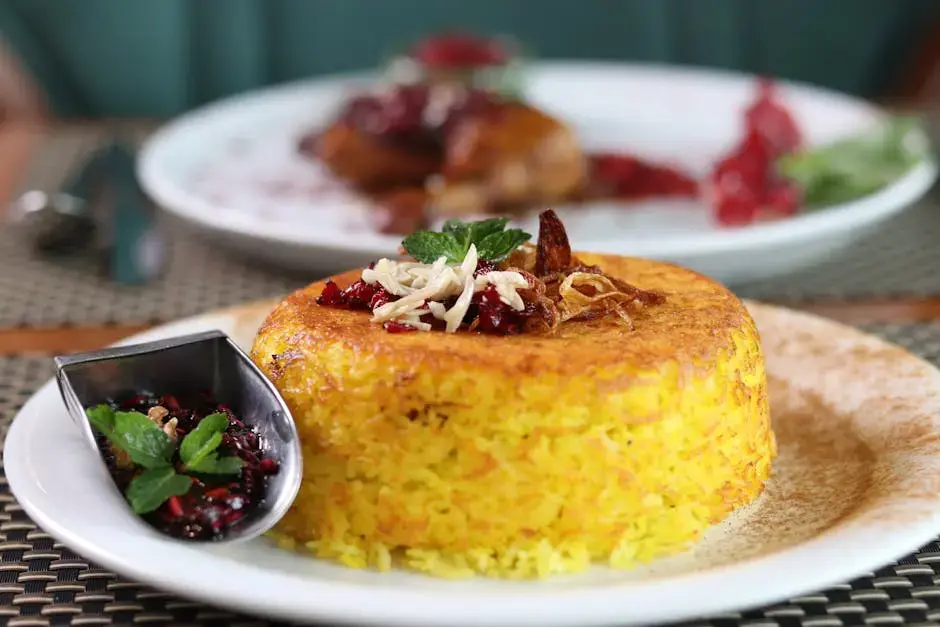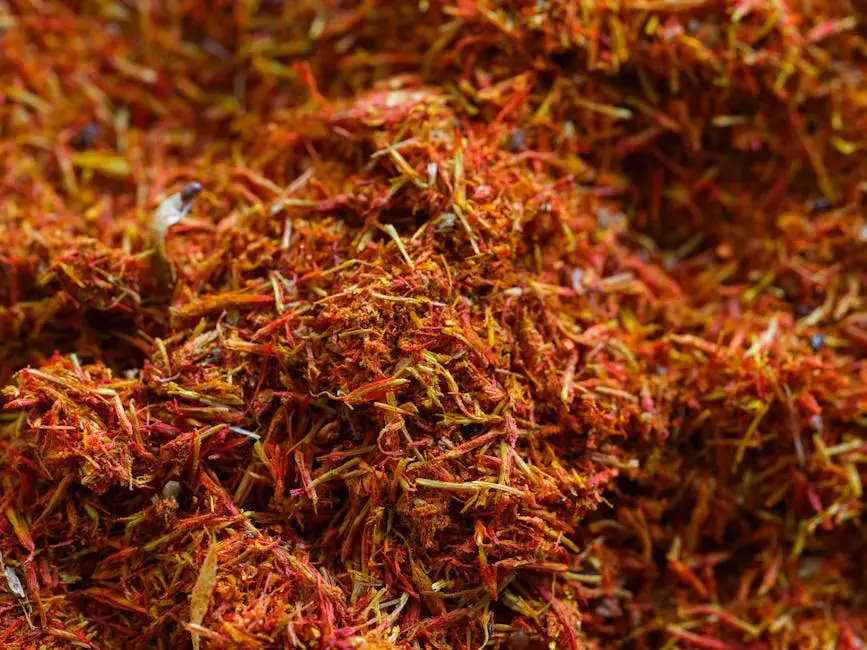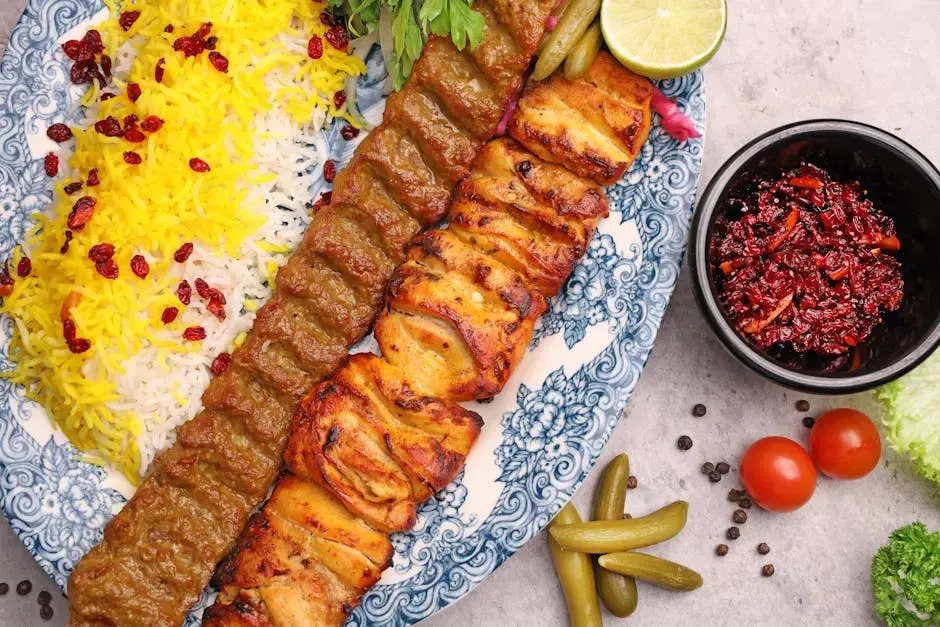From Kebabs to Pita: Unpacking the Diversity of Traditional Persian Dishes
- Chelo
- Apr 19, 2024
- 7 min read
Introduction to Traditional Persian Cuisine
Persian cuisine is more than just food; it's a canvas of flavors, colors, and textures, rich in history and tradition. Think of it as a journey that takes your taste buds back in time. This is not your everyday meal prep. Persian food combines simple ingredients like rice and bread with a mix of spices, herbs, fruits, and nuts to create dishes that are as nutritious as they are delicious. Kebabs, for instance, are not just meat on a stick. They're marinated in a blend of spices and grilled to perfection, often served with saffron-infused rice or wrapped in a soft, warm pita. But there's more. Stews (or "khoresht") slow-cooked to perfection, fragrant rice dishes ("polo") mixed with anything from barberries to lentils, and crispy flatbreads are staples here. Each dish tells a story, every flavor takes you on a voyage. No need for a passport, just a plate and perhaps a side of adventurous spirit.

The Rich History Behind Traditional Persian Dishes
The roots of traditional Persian dishes stretch back over thousands of years, blending flavors from cultures that spanned the ancient Persian Empire. This cuisine is a testament to the rich history of a region that traded ideas and ingredients with neighbors and invaders alike. Imagine the bustling bazaars where spices from India mixed with herbs from the Mediterranean, creating a fusion that's alive in the Persian kitchens of today. Back then, meals were more than just food; they were expressions of hospitality and celebration. The famous Persian poet, Ferdowsi, even celebrated this cuisine in his epic, "Shahnameh," highlighting dishes that have been loved for generations. Over time, Persian food has evolved, but at its core, it remains deeply connected to its ancient roots. Each recipe, from fragrant saffron rice to hearty stews, tells a story of lands rich in culture and history. Through conquests and trade, Persian cuisine adopted new tastes and ingredients, making it a vibrant mosaic of the many peoples who've traversed its lands. It's this blend of history and flavor that makes traditional Persian dishes a fascinating journey for the taste buds and the mind.
Exploring the Variety of Kebabs in Persian Cooking
When you think of Persian cuisine, kebabs might be the first thing that comes to mind. And you're not wrong; kebabs are a cornerstone of Persian culinary tradition. But, the variety might surprise you. Let's slice into this. First off, there's Koobideh, ground meat, usually lamb or beef, seasoned and grilled on skewers. It’s the go-to for many kebab lovers. Next, we have Joojeh Kebab, which is all about marinated chicken grilled to perfection. For those who like a bit of green with their grill, Barg Kebab serves up slices of lamb or beef, marinated, then grilled, usually alongside vegetables. Don’t sleep on Mahi Kebab, where fish gets a turn on the skewer, showcasing the diversity beyond meat. Each variety not only brings its own flavor but also its unique preparation and cultural story. You see, it's not just about sticking meat on a stick; it's a culinary art that spans centuries, carrying with it the flavors, techniques, and traditions of Persian culture. So, next time you’re munching on a kebab, remember, you’re tasting a piece of history.
Pita Bread: An Essential Part of Persian Meals
Pita bread isn't just bread; it's the heart of many Persian meals. This fluffy, light bread is a staple, perfect for scooping up hummus, wrapping kebabs, or just enjoying on its own. You'll find pita in nearly every Persian household, not just because it's delicious, but because it's versatile. Making pita involves simple ingredients like flour, water, yeast, and salt. Yet, the magic happens in the baking process, where it puffs up to create a pocket, making it ideal for filling with all sorts of goodies. Its history is as rich as its taste, tracing back thousands of years, showing just how essential it has been to meals across the Middle East. So, when you bite into that soft, warm pita, remember, you're enjoying a piece of history.
The Role of Rice in Persian Dishes
Rice isn't just a side dish in Persian cuisine; it's the star of the show. In Iran, rice, or 'polo', is cooked with precision and passion, showcasing an array of flavors and textures that are unmatched. Each grain stands out, fluffy and fragrant, hinting at the care taken in its preparation. Basmati rice is typically used, known for its long grains and aromatic scent. But it's not just about boiling rice; it's an art. There's 'chelo', plain rice served with a golden crust at the bottom known as 'tahdig', loved for its crispy texture. Then, there are the countless variations of 'polo' mixed with herbs, fruits, nuts, and meats, each creating a unique dish that tells a story of Iran's regions and seasons. It's a testament to the versatility and central role rice plays in Persian dining, turning simple ingredients into celebrations of flavor.
Stews and Soups: Comfort Food, Persian Style
In the heart of every Persian kitchen, stews and soups hold a special place. They're not just meals; they're a warm hug on a cold day, a filling feast for a family gathering. One of the most beloved stews is Ghormeh Sabzi. This dish combines fresh herbs, kidney beans, and chunks of meat, simmered to perfection over hours. It's rich, it's fragrant, and it embodies the essence of Persian comfort food. Another staple is Fesenjan, a unique stew made with pomegranate paste and ground walnuts, usually cooked with chicken or duck. It's sweet, sour, and entirely unforgettable. Then, there's Ash, a term that covers a variety of thick soups, each a universe of flavor. Ash Reshteh, for instance, is packed with noodles, beans, herbs, and topped with kashk, a type of whey, creating a creamy, tangy dish that's both satisfying and nutritious. These dishes showcase the warmth and richness of Persian cuisine, making them perfect for anyone looking to explore comforting flavors from around the globe.
Sweet Treats in Persian Cuisine
When talking about Persian cuisine, it's easy to lose oneself in the rich flavors of spices, meats, and rice. However, the sweet treats are a world of their own that deserve special mention. Persian sweets aren't just about sugar; they're an artful blend of flavors, textures, and traditions passed down through generations. Persian baklava, for example, is a must-try. It's layers upon layers of light pastry, filled with nuts and soaking in a sweet, rose water-infused syrup. Then there's Faloodeh, a refreshing sorbet made of thin vermicelli noodles, frozen in a semi-sweet syrup, often served with lime juice and cherries. It's a beloved dessert during the hot summer months. Don't overlook Sohan, a crunchy, toffee-like candy topped with pistachios, a favorite treat during Persian New Year celebrations. Each sweet tells a story of regions, seasons, and festivities, making the exploration of Persian desserts not just a culinary journey but a cultural one too. So next time, while diving into the deep flavors of Persian dishes, save some room for these sweet treats. They're the perfect end note to the symphony of tastes that Persian cuisine offers.
Spices and Flavors Unique to Persian Dishes
Persian cuisine is way more than just a meal; it's a festival of flavors and spices that dance together in perfect harmony. At the heart of Persian dishes lie spices like saffron, the most prized of them all, bringing a golden hue and a taste of luxury to every dish it touches. Then we got turmeric, giving dishes their vibrant yellow color and earthy flavor. Next up, sumac, with its tangy lemony kick, perfect for adding a bit of zest. And of course, cardamom and dried limes, bringing in a burst of aromatic and sour tones. These spices don't just add taste; they tell the story of Persian culture, tradition, and the lands from which they come. So, the next time you're enjoying a Persian dish, remember, it's not just food. It's centuries of history and culture on your plate, all thanks to these iconic spices.
Vegetarian Options in the Persian Culinary World
Within the rich tapestry of Persian cuisine, meat-heavy dishes often steal the spotlight. However, the Persian culinary world offers a delightful array of vegetarian options that are not only flavorful but deeply rooted in the culture's history and traditions. Vegetarian or not, diving into these dishes provides a glimpse into the diversity and richness of Persian cuisine. Among the popular vegetarian dishes is Ash Reshteh, a hearty soup made with noodles, beans, herbs, and a tangy whey sauce called kashk, offering a unique blend of textures and flavors. Then there's Kuku Sabzi, essentially a Persian frittata loaded with fresh herbs, eggs, and sometimes barberries, providing a bright and aromatic taste experience. For a side or a light meal, Mirza Ghasemi, a smoky eggplant dish flavored with garlic, tomato, and turmeric, served with bread, is a must-try. Let's not forget about the various kinds of dolmas (stuffed vegetables) and salads like Shirazi salad, a refreshing mix of cucumber, tomato, onion, and a zesty lime dressing. These vegetarian delights showcase that Persian cuisine's variety goes well beyond kebabs, offering dishes that cater to a range of tastes while staying true to its flavorful and aromatic essence.
Where to Find and How to Experience Traditional Persian Dishes
Finding and experiencing traditional Persian dishes is surprisingly simple once you know where to look. First, scout for authentic Persian restaurants in your city. A quick online search or asking for recommendations on social media can lead you to local gems that serve authentic Persian cuisine. When you're there, don't just stick to the well-known kebabs. Be adventurous. Try dishes like Fesenjan, a rich stew with pomegranate and walnuts, or Ghormeh Sabzi, packed with herbs and kidney beans. For a truly immersive experience, find a local Iranian market. Here, you can buy ingredients like saffron, barberries, and rose water that are staples in Persian cooking. Then, try preparing a dish at home. Cooking channels on YouTube or cooking blogs can guide you through traditional recipes. Remember, Iranian cuisine is all about flavor balance and hospitality, so share your meal with friends or family to truly embrace its essence.




Comments